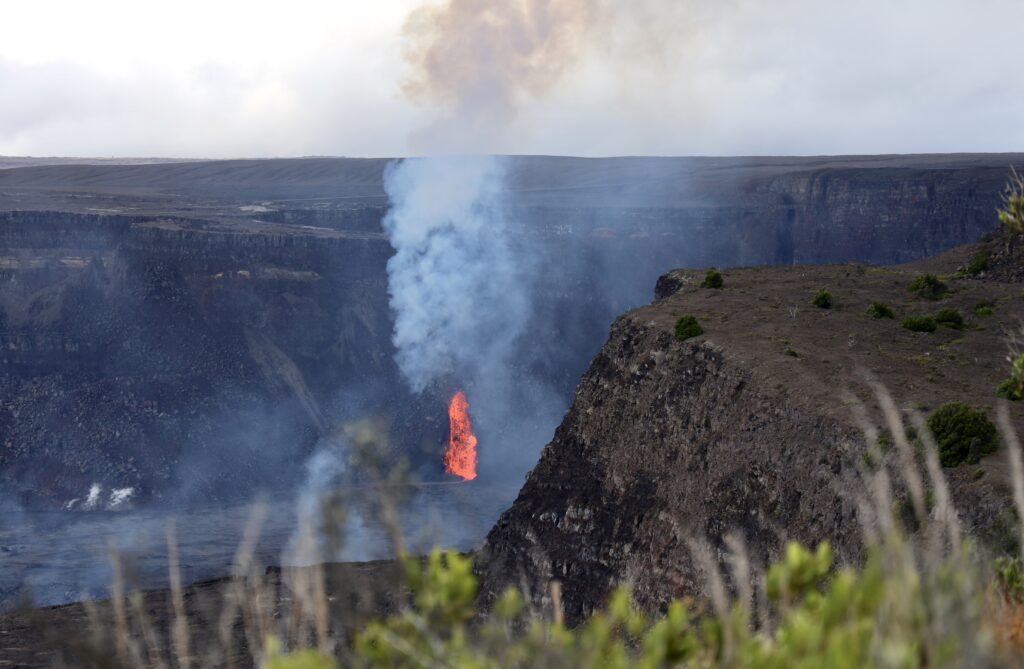
Hawai‘i Volcanoes National Park is located on the Big Island of Hawaii, the biggest and the youngest island in the chain. This National Park extends from the sea level to 13,680 ft. and is home to the summits of two active volcanoes – Kīlauea (one of the most active volcanoes in the world) and Mauna Loa.
Visiting this national park is a must-do when you are on the Big Island, and if you are lucky, you can even witness the glorious flowing lava on the bottom of the caldera.
It’s no surprise that Hawai‘i Volcanoes National Park has been recognized as an International Biosphere Reserve and a UNESCO World Heritage Site. Let’s review some important information before planning your next trip to Hawai‘i Volcanoes National Park.
What to pack for Hawaii?
To help you prepare for your journey to St. Kitts and Nevis, we’ve put together a comprehensive family packing list that covers everything you’ll need to make the most of time on the islands.
Where is Hawai‘i Volcanoes National Park?
Hawai‘i Volcanoes National Park is located on the eastern part of the Big Island, Hawaii. It is about 2 hours and 15 minutes drive from Kona and 45 minutes from Hilo. So if you plan on staying on the Kailua-Kona side of the island, plan your trip accordingly since it will take over 2 hours to drive to the park.
To save time on the road, many people opt to stay on the Hilo side of the island when visiting Hawai‘i Volcanoes National Park.
How to get to Hawai‘i Volcanoes National Park?
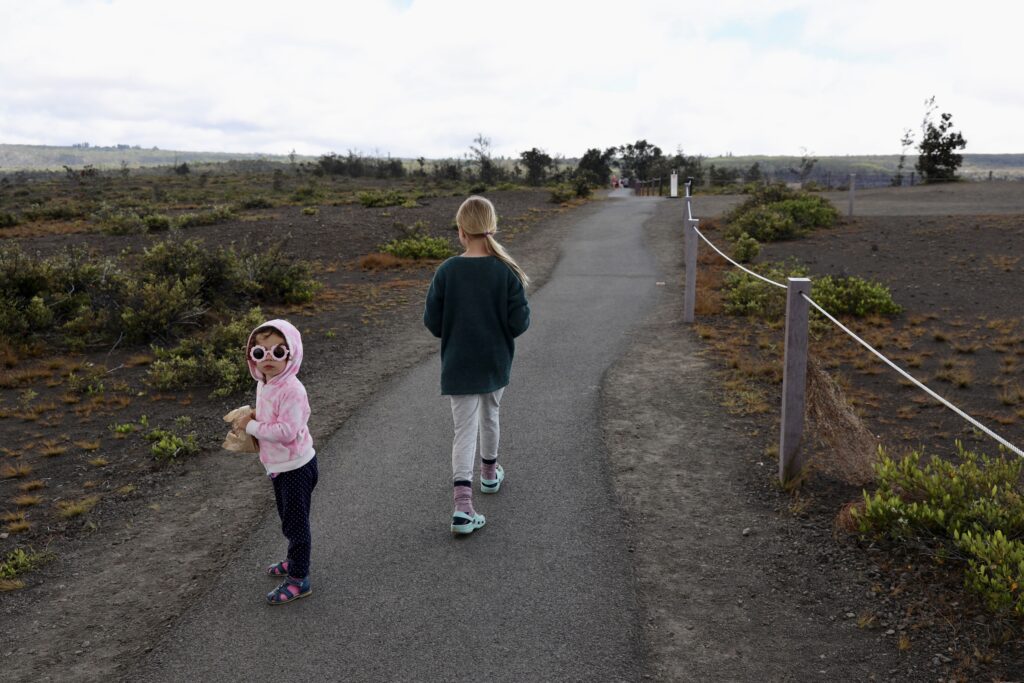
How to get to Hawai‘i Volcanoes National Park:
- One of the easiest ways to reach Hawai‘i Volcanoes National Park is by renting a car and driving at your own pace. If you don’t wish to rent a car for your entire trip, renting one for a day is also a great alternative.
- If you’re looking for public transportation, the Hele-On Bus is your best bet. They offer the only public transit to Hawai‘i Volcanoes National Park, with service from Hilo Monday-Friday.
- Multiple companies offer 4-6 hour tours on tour buses with a hotel pick-up and drop-off. The cost of the tour may vary depending on the number of stops and sightseeing spots you opt for.
Please be aware that no shuttle bus or public transportation is available within the park. Additionally, using Rideshare apps within the park may be challenging due to their limited availability.
What to pack to Hawai‘i Volcanoes National Park

What are some of the things we recommend packing before heading to the park:
- Snacks and water. Staying hydrated is one of the most important things when you hit the trails, so bring enough water for each member of your party.
- Sturdy shoes. Most of the time, the trail was covered in small lava rocks and was slippery right after the rain, so make sure the wear sturdy, comfortable shoes.
- Rain jacket/poncho. Make sure to grab a rain jacket since it rained almost the whole time we were there. The temperatures dropped when entering the volcano area, but it was not cold enough to wear warm jackets, at least in summer.
Entrance Fees to Hawai‘i Volcanoes National Park
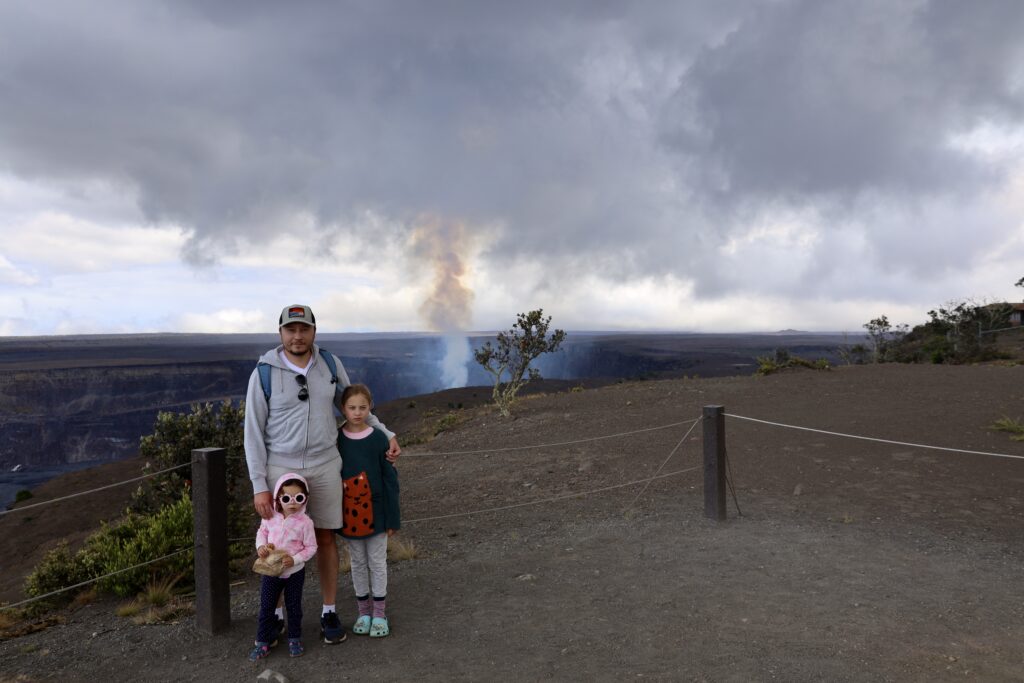
The entrance fee to Hawai‘i Volcanoes National Park is $35 per vehicle, and this Standard Entry Pass is valid for seven days from the day of the purchase.
Since Hawai‘i Volcanoes National Park is a part of the U.S. National Parks system, you can also use your America the Beautiful Interagency Annual Pass to enter the park for free.
If you are planning on visiting more than three national parks per year, we highly recommend investing in the Interagency Annual Pass. The pass costs $80 and is valid for 12 months from the moment of purchase (it can be bought right at the kiosk of the national park entrance).
💡 Good to Know
Starting on May 26, 2023, entry fees and passes for Hawai’i Volcanoes National Park can only be paid using credit or debit cards. Cash payments will no longer be accepted.
Map of Hawai‘i Volcanoes National Park
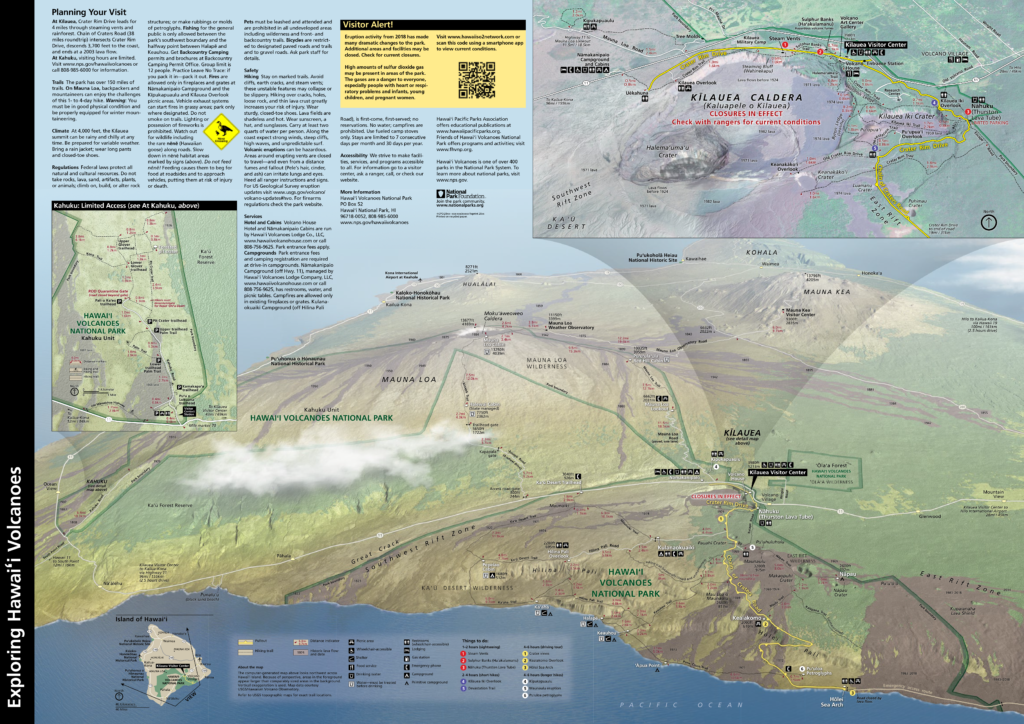
Where to stay in Hawai‘i Volcanoes National Park
When visiting Hawai‘i Volcanoes National Park, you have a few lodging options to choose from. You can definitely stay at your preferred hotel anywhere on the island and make a day trip to the national park. Keep in mind that Hilo is much closer to the national park, so staying on that side of the island would require fewer hours on the road.
However, there is a great opportunity to stay right in the Hawai‘i Volcanoes National Park at the Volcano House. Volcano House, established in 1846, has been renovated and offers 33 historic rooms, a dining area, and a lounge; they also host cultural events and presentations.
Volcano House also manages ten camper cabins and campsites in the nearby Nāmakanipaio Campground.
💡 Good to Know
Since many people opt to visit the national park at night to see the “glow” of the lava, staying directly in the park also allows you to reach the viewing spot within minutes.
The good news is that Hawai‘i Volcanoes National Park is open 24 hours, so plan your trip accordingly.
Dining in Hawai‘i Volcanoes National Park
The Volcano House, located right by the Kīlauea Visitor Center, offers two dining options – The Rim at Volcano House and Uncle George’s Lounge. Both of them are open for breakfast, lunch, and dinner, with some closures in between.
Since we planned on having a later dinner, we just stopped in Hilo and tried the delicious traditional Japanese cuisine at Izakaya Miyo restaurant!
Hawai‘i Volcanoes National Park Visitor Center
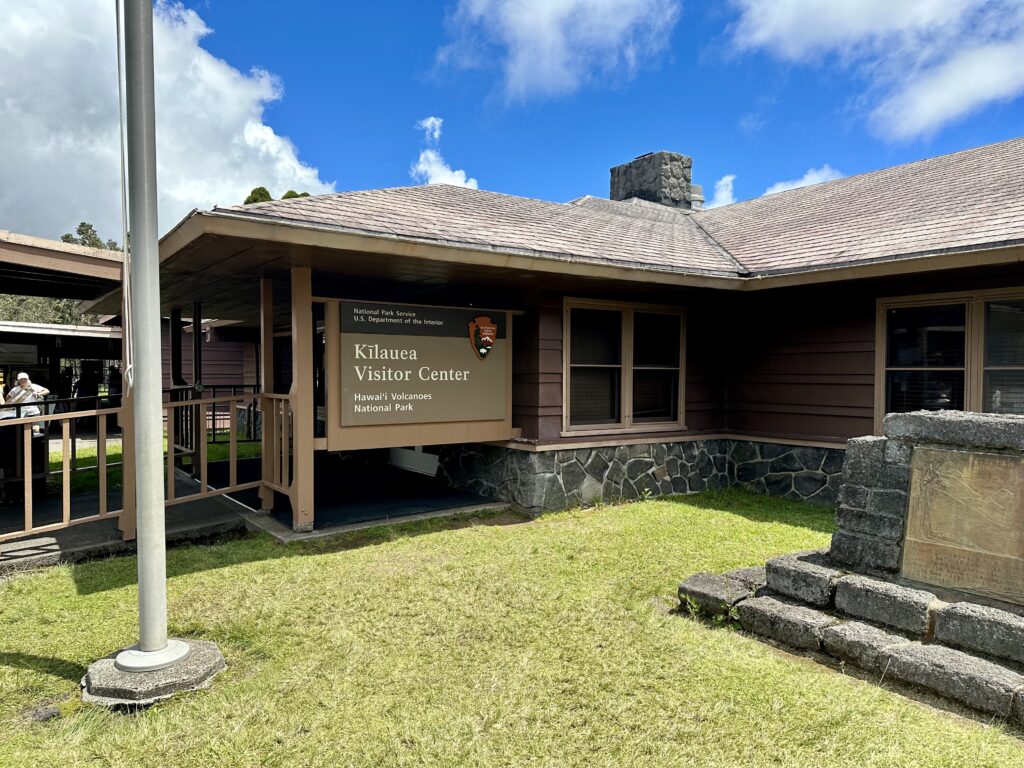
Whenever visiting a National Park, the very first thing to do is go to a Visitor Center. In this building, you will find all the information about the park, trails, and current conditions.
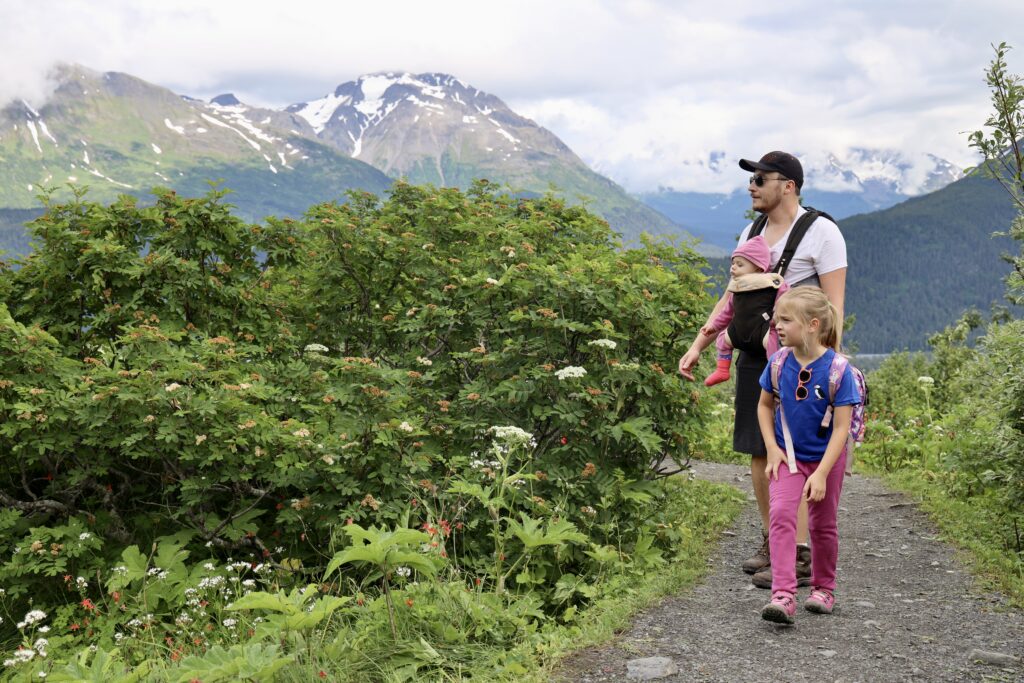
Everything you need to know about visiting National Parks with kids
After visiting 20 National Parks with our kids and experiencing their unique beauty, we have put together a guide detailing the essentials of planning and participating in park programs to ensure a rewarding family adventure in the National Parks.
Continue reading →
The Kīlauea Visitor Center had a small display museum about the Hawai‘i Volcanoes National Park, a Theater room, and a gift shop. They did not offer any dining options, but there are two restaurants at the nearby lodge called the Volcano House.
Kīlauea Overlook
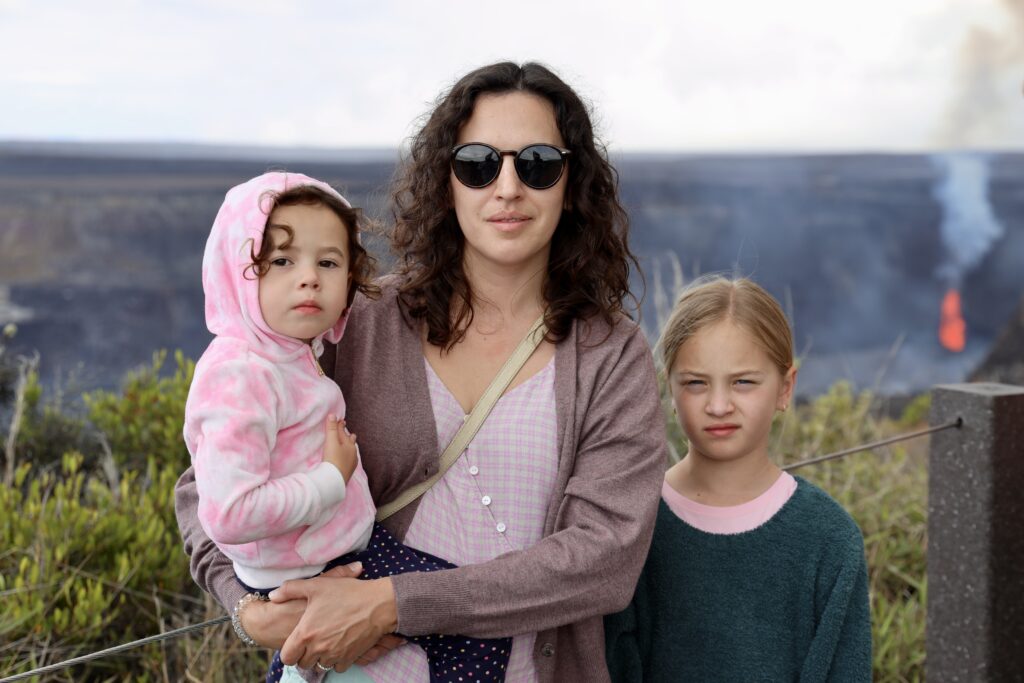
💡 Good to Know
Before heading out to Hawai‘i Volcanoes National Park to view the erupting Kīlauea volcano, we recommend checking the live webcam for current conditions. Additionally, check in with the Park Ranger at the Visitor Center for the best spot to observe the eruption.
The most memorable moment of our trip was visiting Hawai‘i Volcanoes National Park and witnessing the eruption of Kīlauea volcano. We were fortunate that the eruption began a week before our trip, as observing the lava flow in the volcano’s caldera was a top item on our must-see list (only when it was safe to do so obviously).

Kīlauea Overlook was within a short drive from the Kīlauea Visitor Center, but the nearby parking lot had very limited space.
As the Park Ranger recommended, we took the Crater Rim Dr. a little further and parked our car in another area. There was a nice short paved path from the parking area down to the Kīlauea Overlook.
Rainforest
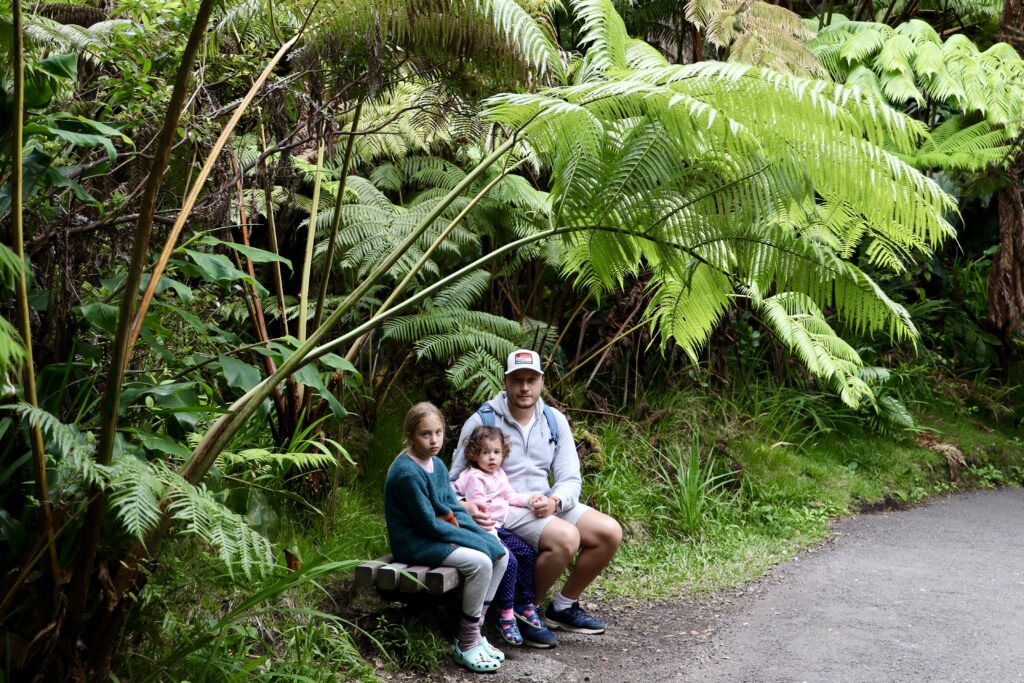
Hawai’i Volcanoes National Park encompasses 335,259 acres of volcanoes, trails, rainforests, and more. I must admit that coming from the hot eastern part of the Big Island with dry weather and lava rock fields on the side of the road, we were surprised to end up in a tropical rainforest.
We had the pleasure of walking through the rainforest on our way to the famous Nāhuku (Thurston Lava Tube). This amazing part of the national park definitely lives up to its name – it is a beautiful lush forest, and it rained most of the time 😅.
Nāhuku (Thurston Lava Tube)
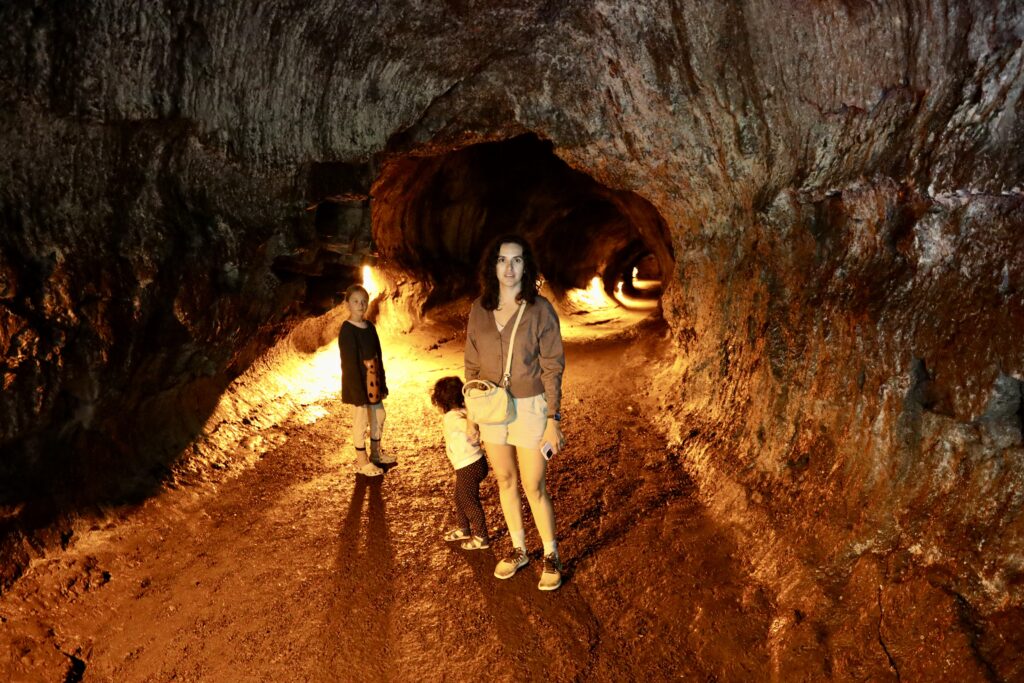
When in Hawai’i Volcanoes National Park, make sure to visit Nāhuku, also known as Thurston Lava Tube. This 500-year-old lava tube was once a channel for a river of lava that had temperatures as high as 2,000° Fahrenheit (1,093° Celsius). It’s an adventure you wouldn’t want to miss!
Trailhead: Nāhuku (Thurston Lava Tube) parking area or Kīlauea Iki Overlook if Nāhuku parking area is full
Round-trip Distance: 0.5 mi from Nāhuku parking area; 1.5 mi round-trip walk from Kīlauea Iki Overlook; 6.0 mi round-trip from Devastation Trailhead (including the Kīlauea Iki loop)
Time: 30 minutes to 1 hour.
Level: easy, loop-shaped trail
Elevation: no significant elevation gain/loss
You can enjoy a short paved walk from the parking lot to the entrance of the Lava Tube through the rainforest. The Lava Tube itself took us around 10 minutes to finish. Our girls we really excited and even asked us to go through the tunnel twice.
Make sure to bring a flashlight and wear sturdy shoes; it is wet and slippery inside.
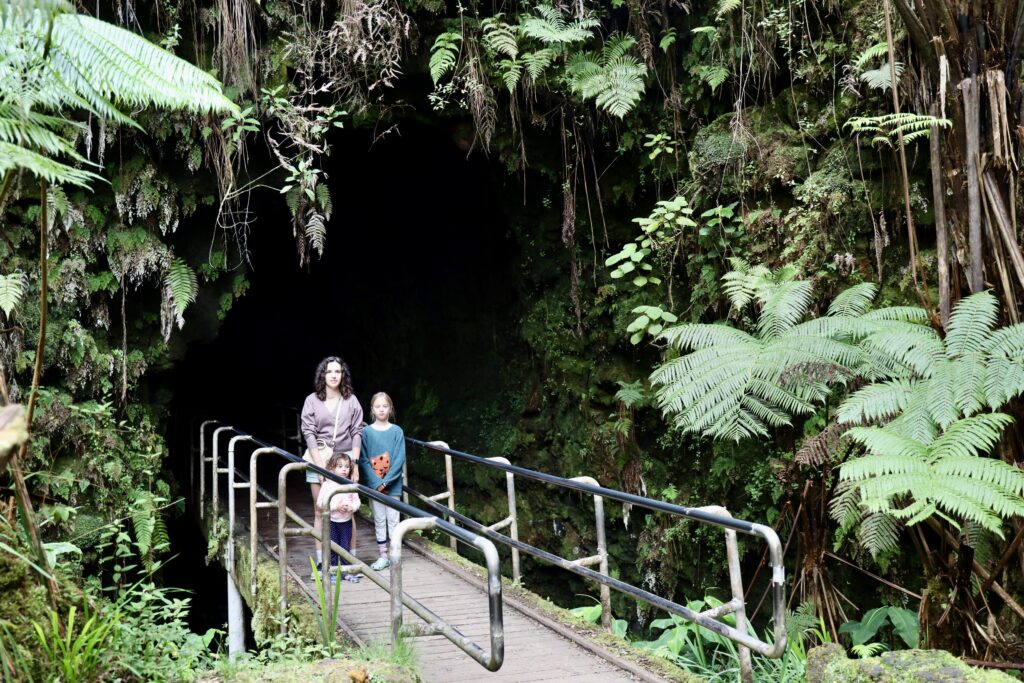
Devastation Trail
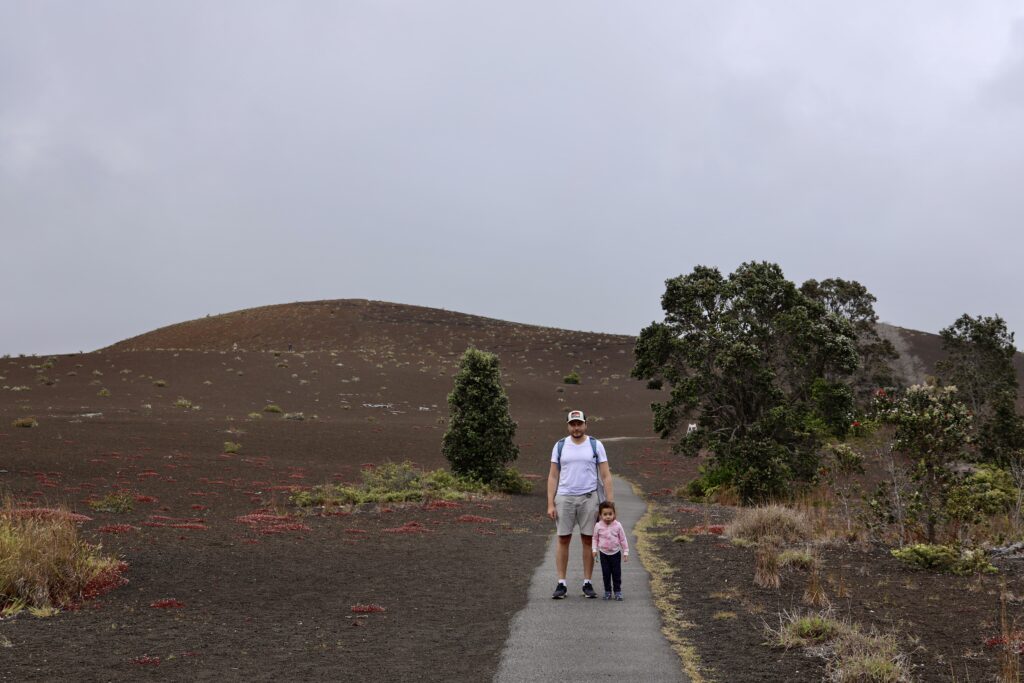
Devastation Trail offers a paved walkway that takes you through a terrain covered in cinder from the lava fountains of the Kīlauea Iki eruption of 1959!
Trailhead: the Pu’upua’i parking lot or the Devastation Trail parking lot
Round-trip Distance: 1 mile (1.6km)
Time: 30 minutes
Level: easy, paved
Elevation: 55 feet
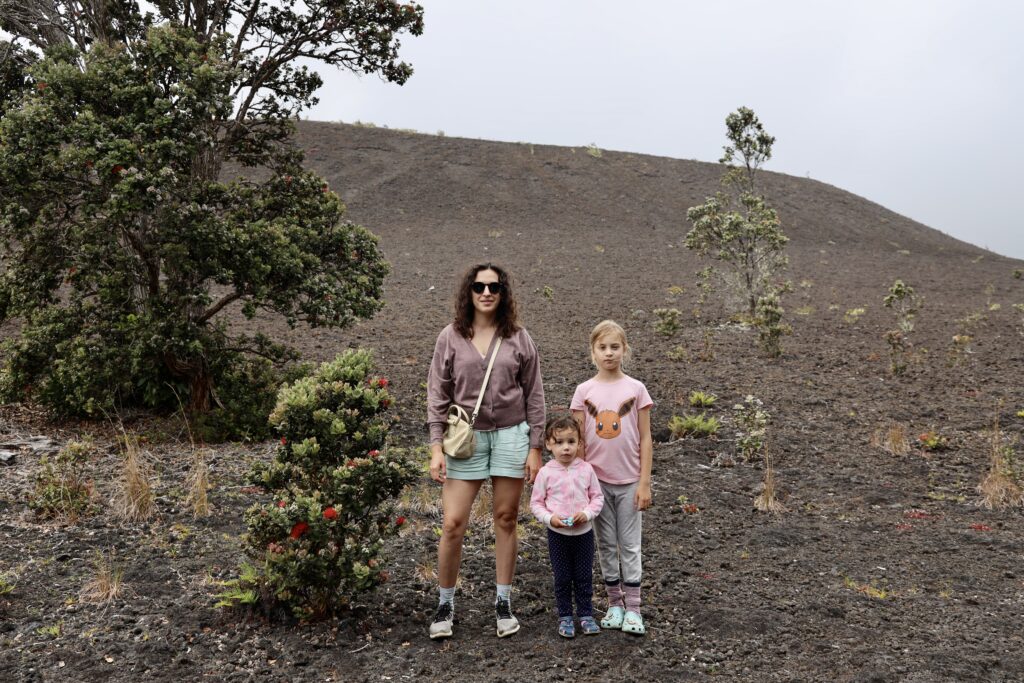
Pelehonuamea (Pele), the goddess of volcanism
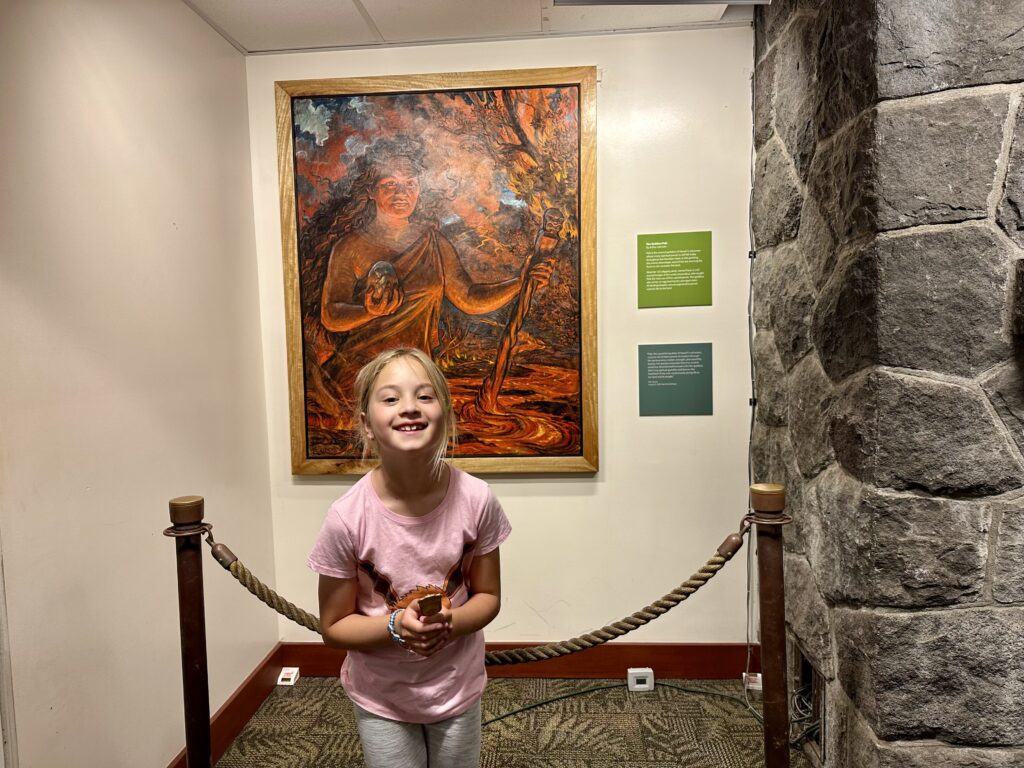
The youngest and most active volcano on the island of Hawaiʻi, Kīlauea, is considered sacred by the Native Hawaiians. The volcano was and still is associated with Pelehonuamea (Pele), the goddess of volcanism. Kīlauea features several significant locations, such as Kaluapele (Kīlauea caldera), a center for cultural practices honoring Pele, and Halemaʻumaʻu, the crater considered her dwelling place.
And according to Hawaiian tradition, it is appropriate to seek permission from Pele before venturing through her land and the sacred terrain.
There are many noteworthy places in the region, such as Wahinekapu, famous for its steam ceremony, or Kūkamāhuākea, where steam rises in honor of Kū (one of Hawaiʻi’s gods).
Junior Ranger Programm
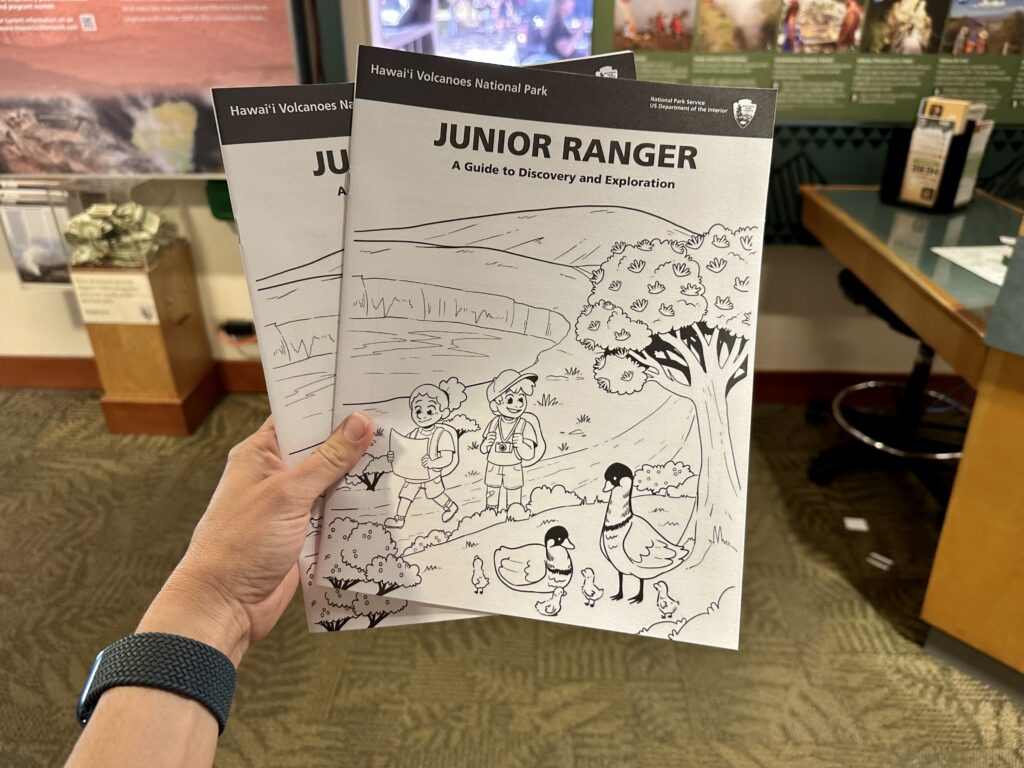
Did you know that every National Park in the U.S. has a Junior Ranger Program? The program involves completing an activity book, answering questions about the park to a Park Ranger, and taking an oath to earn a Junior Ranger Badge.
This program is a fantastic way to encourage children’s interest in nature and the outdoors. Moreover, it’s an excellent chance for families to explore and learn about the National Parks together.
When arriving at the Kīlauea Visitor Center, ask the Park Ranger for the complimentary Junior Ranger activity book. You can complete the book while exploring the National Park and then turn it in to earn a Junior Ranger Badge on your way out.
Leave No Trace
A family trip to a National Park is a great opportunity to teach your kids about the importance of caring for nature and wildlife. One way to do this is by following the Leave No Trace philosophy, which means staying on designated trails, not taking anything from the park, and properly disposing of any waste. By doing these simple things, you can help protect the National Parks for future generations to enjoy!




